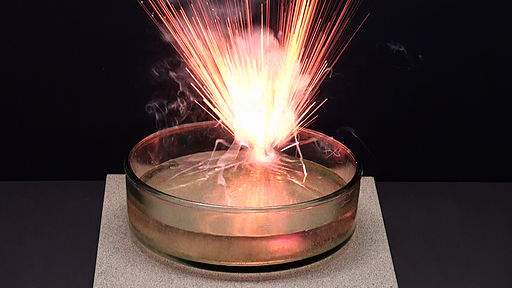10 minutes maximum! Can you do it in 5?
1. Group 1 elements all react in a similar way because they ...
A: are all listed in the same group on the Periodic Table.
B: are all silver colored metals.
C: all have one outer electron.
D: all have a low density and melting point.
A B C D
Q2-3 . Small, similar sized pieces of three different alkali metals, X, Y and Z, were added to water. The time taken for each piece to react completely was recorded:
Metal Time taken to react (s)
X
29
Y
7
Z
45
Tavoromann |
CC-BY-SA 3.0
2. The order of reactivity of these metals from most to least reactive is ...
A. X>Y>Z
B. Z>Y>X
C. Y>X>Z
D. Z>X>Y
A B C D
3. X, Y and Z could be ...
X Y Z
A sodium
potassium
lithium
B sodium
lithium
potassium
C potassium
sodium
lithium
D lithium
potassium
sodium
A B C D
4. Three observations that would be made when a small piece of sodium is added to water in a trough are ...
A: sodium sinks, fizzes and becomes smaller and disappears
B: sodium sinks, melts into a ball and becomes smaller and disappears
C: sodium floats, fizzes and becomes smaller and disappears
D: sodium floats, melts into a ball and burns with a lilac flame
A B C D
5. The word equation for the reaction between sodium and water is ...
A: sodium + water → sodium oxide + hydrogen
B: sodium + water → sodium hydroxide + hydrogen
C: sodium + water → sodium hydroxide + oxygen
D: sodium + water → sodium hydride + oxygen
A B C D
6. The alkali metals, lithium, sodium and potassium, react vigorously with the halogens, chlorine, bromine and iodine.
Which of these is the most vigorous reaction combination?
Alkali Metal Halogen
A lithium
iodine
B lithium
chlorine
C potassium
iodine
D potassium
chlorine
A B C D
7. Sodium burns in chlorine producing sodium chloride. The correct balanced equation for this reaction is ...
A. Na + Cl2 → NaCl
B. 2Na + Cl2 → 2NaCl
C. Na + Cl → NaCl
D. Na + Cl2 → NaCl2
A B C D
8. The table below shows the melting point of some alkali metals.
Alkali Metal Atomic Number Melting Point (o C)
Sodium
11
98
Potassium
19
?
Rubidium
37
39
Caesium
55
28
Predict the melting point of potassium using the data in the table.
A. 110 o C
B. 63 o C
C. 48 o C
D. 35 o C
A B C D
9. The reactions of lithium and potassium with water are described below:
Alkali Metal
Description of reaction with water
lithium
Moves slowly, fizzes and disappears
potassium
Moves quickly, fizzes and burns with a lilac flame
Which of the following best describes how caesium would react with water?
A. moves very quickly, fizzes and explodes
B. moves very quickly, fizzes and disappears
C. moves quickly, fizzes and burns with a coloured flame
D. moves very slowly, fizzes and disappears
A B C D
10. Select the correct formula for the following potassium compounds:
chloride oxide hydroxide
A
KCl2
K2 O
K(OH)2
B
KCl2
KO
K2 OH
C
KCl
KO
KOH
D
KCl
K2 O
KOH
A B C D
Save and Submit
